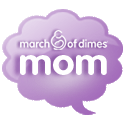***sorry for my lack of posts the past few days - Parker's been sick and we've been busy!***
Heel Stick
Pricking the baby's heel to obtain small amounts of blood for testing.
Hemaglobin
A material in red blood cells that carries oxygen and contains iron.
High Frequency Oscillatory Ventilator
A special ventilator capable of breathing for a baby at rates exceeding those of a normal ventilator (for example, 120 - 1,320 BPM, or Breaths Per Minute).
Hydrocephalus
Abnormal accumulation of cerebrospinal fluid within the ventricles of the brain. It is sometimes known as "water on the brain." Within the center of our brains each of us has two fluid-filled areas called cerebral ventricles. Cerebrospinal fluid is made within these ventricles and distributed over the surface of the brain and spinal cord. When the normal circulation of cerebrospinal fluid is interrupted, fluid can accumulate within the ventricles. This fluid puts pressure on the brain, forcing it against the skull and enlarging the ventricles. In infants, this fluid accumulation often results in bulging of the fontanelle (soft spot) and abnormally rapid head growth. The head enlarges because the bony plates making up the skull have not yet fused together. In preemies the most common cause of hydrocephalus is intraventricular hemorrhage.
I & O (Input & Output)
Refers to the amount of fluids given by oral feedings and/or by IV, and the amount of fluid excreted in the urine or stools.
Isolette
Also known as an incubator, an isolette is a clear plastic, enclosed bassinet used to keep prematurely born infants warm. Preemies often loose heat very quickly unless they are put in a protected thermal environment. The temperature of the isolette can be adjusted to keep the infant warm regardless of the infant's size or room temperature.
Kangaroo Care
Skin-to-skin contact between parent and baby. During kangaroo care, the baby is placed on the parent's chest, dressed only in a diaper and sometimes a hat. The baby's head is turned to the side so the baby can hear the parent's heartbeat and feel the parent's warmth. Kangaroo care is effective, but it's limited to babies whose condition is not critical.
5 days ago








No comments:
Post a Comment